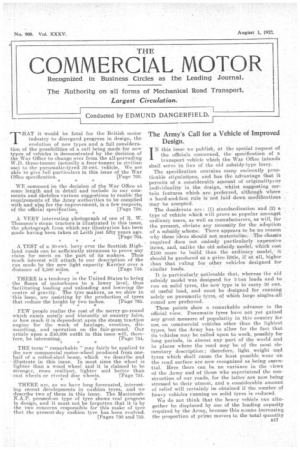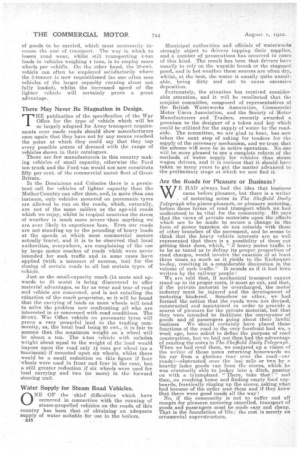The Army's Call for a Vehicle of Improved Design.
Page 1

Page 2

If you've noticed an error in this article please click here to report it so we can fix it.
IN this issue we publish, at the special request of the officials concerned, the epeeification of a transport vehicle which the War Office intends shall serve in lieu of the old subsidy-type lorry.
The specification contains many eminently practicable stipulatiens„ and has the -advantage that it permits of a considerable amount of originality,' or individuality in the design, whilst suggesting certain features which .are preferred, although where a hard-and-fast rule is not laid down modifications
may be accepted. , The desiderata are : (1) standardization and (2) a type of vehicle which will prove so popular amongst ordinary users, as well as manufacturers, as will, for the present, obviate any necessity for the adoption of a subsidy scheme. There appears to be no reason why these ideas should not materialize. The chassis required does not embody particularly expensive items, and, unlike the old subsidy model, which cost f.100 more to build than the ordinary model, it should be produced at a price little, if at all, higher than that ruling for other vehicles designed for similar loads.
It is particularly noticeable that, whereas the old subsidy model was 'designed for 3-ton loads and to run on solid tyres; the new type is to carry 30 cwt. of useful load, and must be designed for running solely on pneumatic tyres, of which large singles..all round are preferred.
These points show a remarkable advance in the official view. Pneumatic tyres have not yet gained any great measure of popularity in this country for use• on commercial vehicles other than the lightest types, but the Army has to allow for the fact that its vehicles may be called upon to work, possibly for long periods, in almost any part of the world and in places where the road may be of the most elementary description ; therefore, light weight ad tyres which shall, cause the least possible wear on the road surface are now recognized as being essential. Here there can be no variance in the views of the Army and of those who superintend the construction of our roads, for the latter are now being stressed to their utmost, and a considerable amount of relief will certainly be obtained if the number of heavy vehicles running on solid tyres is reduced.
We do not think that the heavy vehicle can altogether be displaced by one of the loading capacity required by the Army, because this means increasing the proportion of prime movers to the total quantity
of goods to be carried, which must necessarily increase the cost of transport. The way in which to lessen road wear; whilst still transporting 4-ton loads in vehicles weighing 4 tons, is to employ more wheels per vehille. On the other hand, the 30-cwt. vehicle can often be employed" satisfactorily where the 3-tonner is now requisitioned (as one often sees vehicles of the larger capacity running about not fully loaded), whilst the increased speed of the lighter . vehicle will certainly prove a great advantage.
There May Never .Be Stagnation in Design.
THE publication of the specification of the War Office for the type of vehicle which will be so largely adopted for Army transport requirements over made roads should show manufacturers once again that they have not by any means reached the point at which they could say that they tap every possible source of demand with the range of vehicles shown in their catalogues.
There are few manufacturers in this country making vehicles of small capacity, otherwise the Ford ton truck and the Ford Van would not now constitute fifty per cent. of the commercial motor fleet of Great Britain.
In the Dominions and Colonies there is a persistent; call for vehicles of lighter capacity than the Mother Country can offer them, and, in more than one instance, only vehicles mounted on pneumatic tyres are allowed to run on the roads, which, naturally, are not of the same calibre as the age-old roads which we enjoy, whilst in tropical countries the stress, of weather is much more severe than anything we are ever likely to experience here. Even (air roads are not standing up to the pounding of heavy loads at the speeds at which most commercial motors actually 'travel, and it is to be observed that local authorities, everywhere, are complaining of the use by large motor coaches of roads which were never intended for such traffic and in some cases have applied (with a measure of success, too) for the closing of certain roads to all but certain types of vehicle.
Just as the small-capacity coach (14 seats and upwards to 23 seats) is being discovered to offer material advantages, so far as wear and tear of road and vehicle are concerned, and is not entailing the raination of the coach proprietor, so it will be found that the carrying of loads on more wheels will tend to solve the problem now confronting all who are interested in or concerned with road conditions. The 30 cwt. War Office vehicle on pneumatic tyres will prove a very powerful lead to -the trading community, as, the total load being 60 cwt., it is fair to assume that the maximum weight on a wheel will be about a ton. The 4-ton vehicle with unladen weight about equal to the weight of the load would impose upon the road only 1* tons per wheel (as a Maximum) if mounted upon six wheels, whilst there would be a small reduction on this figure if four wheels were used in front and four in the rear, but a still greater reduction if six wheels were used for load carrying and two (or more) in the forward steering unit.
Water Supply for Steam Road Vehicles.
ONE OF the 'chief difficulties which have occurred in connection with the running of steam-propelled vehicles on the roads of this country has been that of obtaining an adequate supply of water suitable for use in the boilers.
B/8 Municipal authorities and officials of watertvorlai strongly object to drivers tapping their supplies, and a number of prosecutions has occurred in cases of this kind. The result has been that drivers have usually to rely on the wayside brook or the stagnant pond, and in hot weather these sources are often dry, whilst, at the best, the water is usually quite unsuitable, being dirty and ant to cause excessive deposition.
Fertunately, the situation has received considerable attention, and it will be recollected that the conjoint committee, composed of representatives of the British Waterworks Association, Commercial Motor Users Association, and the Society of Motor Manufacturers and Traders, recently awarded a premium to the designer of a token and key which' could be utilized for the supply of water by the roadside. The committee, we are glad to hear, has now taken the next step of asking for tenders for the supply of the necessary mechanism, and we trust that the scheme will soon be in active operation. No one will be more pleased to see a complete reform of the methods of water supply for vehicles than steam • wagon drivers, and it is curious that it. should have taken so many years to get the matter advanced to the preliminary stage at which We now find it
Are the Roads for Pleasure or Business?
E HAD always had the idea that business came before pleasure, but there is a writer
of Motoring notes in The Sheffield Daily Telegraph who places pleasure, or pleasure motoring, before those forms of road transnort which we had understood to be vital for the community. He says that the views of private motorists upon the efforts which are to he made to secure a change in the form of motor taxation do not coincide with those of other branches of the movement, and he seems to think that the heavy vehicle interests are so well represented that there is a possibility of them not getting their dues' which, if heavy motor traffic is to be so taxed as to defray its proper proportion of road charges, would involve the exaction of at least three times as much as it yields to the Exchequerto-day, resulting in a considerable diminution in the volume of such traffic." It sounds as if it had been written by the railway people !
We are told that, if mechanical transport cannot stand up to its proper costs, it must go out, and that, if the private motorist be overcharged, the motoi." industry must be injured and the development of motoring hindered. Somehow or other, we had formed the notion that the roads were not devised, constructed and maintained in order to provide a source of pleasure for the private motorist, but that they were intended to facilitate the " conveyance of goods and of passengers going about their lawful business We ehould certainly have placed those functions of the road in the very forefront had we,"a week ago, been asked to define the purpose of road 2onstruction, but we had not then had the advantage of reading the notes in The Sheffield Daily Telegraph. When we had read them we conjured up a vision of the writer of those nos returning homewards on his car from a glorious tour over the road—oer roads 1—obstructed over the last. mile or two by a heavily laden goods van from the stores, which he was eventually able to jockey into a ditch, passing on with a triumphant "There take that!" and then, on reaching home and finding empty food cupboards, frantically ringing up the stores, asking what had become of the order sent them and if they knew that there were good roads all the way !
No, if the community is not to suffer and all margin for pleasure motoring cancelled, transport of goods and passengers must be made easy and cheap. That is the foundation of life : the rest is merely an ornamental superstructure.






























